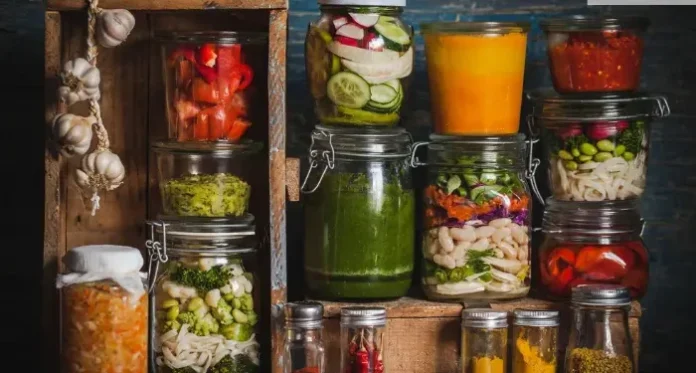Bottled and jarred packaged goods are products that are stored and sold in bottles or jars. These types of packaging are commonly used in the food and beverage industry, but can also be found in other industries such as cosmetics, cleaning products, and pharmaceuticals.
Bottles and jars come in a variety of shapes, sizes, and materials. Glass, plastic, and metal are the most common materials used for these types of packaging. Each material has its own advantages and disadvantages depending on the product being packaged, the storage conditions, and the consumer preferences.
Here is a table summarizing some of the common types of bottled and jarred packaged goods and the materials used for their packaging:
| Product | Packaging Material |
|---|---|
| Fruit juice | Glass, plastic |
| Soda | Aluminum, glass, plastic |
| Ketchup | Glass, plastic |
| Mayonnaise | Glass, plastic |
| Salad dressing | Glass, plastic |
| Pickles | Glass |
| Peanut butter | Plastic, glass |
| Honey | Glass, plastic |
| Jam and jelly | Glass, plastic |
| Salsa | Glass, plastic |
| Pasta sauce | Glass, plastic |
| Cooking oil | Plastic, glass |
| Vinegar | Glass |
| Beer | Glass, aluminum |
| Wine | Glass |
| Spirits | Glass, plastic |
Advantages and disadvantages of different packaging materials:
| Material | Advantages | Disadvantages |
|---|---|---|
| Glass | Recyclable, non-reactive, maintains product quality, provides a premium look and feel | Heavy, breakable, expensive, not suitable for carbonated beverages |
| Plastic | Lightweight, durable, cost-effective, easy to transport and store, suitable for carbonated beverages | May contain harmful chemicals, not as environmentally friendly as other materials, can affect product quality over time |
| Aluminum | Lightweight, recyclable, protects from light and oxygen, suitable for carbonated beverages | More expensive than plastic, not suitable for hot liquids or acidic products, can affect product taste |
| Metal (e.g., tin, steel) | Durable, lightweight, recyclable, protects from light and oxygen | Not suitable for all products, can affect product taste, not as visually appealing as glass or plastic |
Bottled and jarred packaged goods offer many benefits to both manufacturers and consumers. For manufacturers, these types of packaging provide a convenient and efficient way to store and transport products, as well as protect them from spoilage and contamination. Bottles and jars also offer a way to differentiate products on store shelves through unique shapes, sizes, and labeling.
Also Read: Everything About Kim Possible Costume
For consumers, bottled and jarred packaged goods offer convenience and portability. These products can be easily stored in pantries, refrigerators, and cabinets, and can be transported easily for on-the-go consumption. Bottles and jars also allow consumers to see the product inside, which can help with product selection and ensure freshness.
However, there are some potential drawbacks to bottled and jarred packaged goods. First, the materials used for packaging can have an impact on the environment. Glass and aluminum are recyclable, but plastic can take hundreds of years to decompose and can release harmful chemicals into the environment. Additionally, the production and transportation of bottled and jarred packaged goods can contribute to greenhouse gas emissions and other environmental issues.
Another potential issue is the use of preservatives and other additives in these types of products. While preservatives are necessary to prevent spoilage and extend shelf life, some consumers may be concerned about the safety and health implications of consuming these additives. Additionally, some consumers may prefer fresh, unpackaged products for health and sustainability reasons.
Also Read: What are Bagged Packaged Goods?
In conclusion, bottled and jarred packaged goods are a common and convenient way to store and sell products in many industries.





